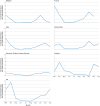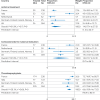Pregnant women admitted to hospital with covid-19 in 10 European countries: individual patient data meta-analysis of population based cohorts in International Obstetric Survey Systems
- PMID: 40519510
- PMCID: PMC12164325
- DOI: 10.1136/bmjmed-2023-000733
Pregnant women admitted to hospital with covid-19 in 10 European countries: individual patient data meta-analysis of population based cohorts in International Obstetric Survey Systems
Abstract
Objectives: To assess the incidence of hospital admissions for covid-19 disease in pregnant women, severity of covid-19 disease, and medical treatment provided to pregnant women with moderate to severe covid-19 during the first 10 months of the pandemic.
Design: Individual patient data meta-analysis of population based cohorts in International Obstetric Survey Systems.
Setting: 10 European countries with national or regional surveillance within the International Obstetric Survey Systems (INOSS) collaboration using aligned definitions and case report forms: Belgium, France (regional), Italy, the Netherlands, Denmark, Finland, Iceland, Norway, Sweden (regional), and the UK. The dominant variant of the SARS-CoV-2 virus was the wild-type variant in all countries during the study period (1 March 2020 to 31 December 2020).
Participants: The source population was 1.7 million women giving birth (maternities) from 1 March 2020 to 31 December 2020; pregnant women were included if they were admitted to hospital and had a positive polymerase chain reaction test for the SARS-CoV-2 virus ≤7 days before hospital admission, during admission, or up to two days after giving birth. We further categorised the hospital admission in two groups; covid-19 admission (hospital admission due to covid-19 or with reported symptoms of covid-19 disease) or non-covid-19 admission (admission to hospital for obstetric healthcare or no symptoms of covid-19 disease).
Main outcome measures: Incidence of hospital admissions for covid-19 per 1000 maternities, frequency of moderate to severe covid-19 disease, and number of women who received specific medical treatment for SARS-CoV-2 infection. Moderate to severe covid-19 disease was defined as maternal death, admission to an intensive care unit, or need for respiratory support.
Results: Among 1.7 million maternities, 9003 women were included in the study: 2350 (26.1%) were admitted to hospital because of covid-19 disease or had symptoms of disease. The pooled incidence of hospital admissions for covid-19 per 1000 maternities was 0.8 (95% confidence interval (CI) 0.5 to 1.2, τ2=0.44), ranging from no hospital admissions in Iceland to 1.7 in France and 1.9 in the UK. 13 women died due to covid-19. Among 2219 women admitted to hospital for covid-19 in countries with complete information on respiratory support, 820 women (39.5%, 95% CI 34.6% to 44.4%, τ2=0.02) had moderate to severe covid-19 disease. At most, 16.8% (95% CI 7.7% to 32.9%, I2=81.8%, τ2=0.7) of women with moderate to severe covid-19 received specific medical treatment for SARS-CoV-2 infection with corticosteroids, although 66.6% (59.4% to 73.2%, I2=50.1, τ2=0.06) were given thromboprophylaxis.
Conclusions: Population based surveillance in 10 European countries during the first 10 months of the covid-19 pandemic showed variations in the risk of hospital admissions for covid-19 in pregnant women. This finding indicates that national public health policies likely had a substantial and previously unrecognised role in protecting pregnant women. Few pregnant women with moderate to severe covid-19 were given specific medical treatment for SARS-CoV-2 disease, even when there were no or minor safety concerns. Lessons for future pandemics include the importance of rapid, robust surveillance systems for maternal and perinatal health, and of including use for pregnant women early in the development and testing of medicines and vaccines for public health emergencies.
Keywords: COVID-19; Pregnancy complications; Public health.
Copyright © Author(s) (or their employer(s)) 2024. Re-use permitted under CC BY. Published by BMJ.
Conflict of interest statement
All authors have completed the ICMJE uniform disclosure form at www.icmje.org/disclosure-of-interest/ and declare: support from the European Medicines Agency, Belgian Federal Public Service of Health, French Ministry of Health, Norwegian Research Council, Nordic Federation of Societies of Obstetrics and Gynaecology Research Fund, Region of Southern Denmark and Region Zealand’s shared fund for joint health research projects, EasyTrial, Finnish Medical Society, Helsinki University, National Institute for Health and Care Research Health and Social Care Delivery Research programme, and Wellbeing of Women for the submitted work; no financial relationships with any organisations that might have an interest in the submitted work in the previous three years; no other relationships or activities that could appear to have influenced the submitted work.
Figures






References
-
- The World Health Organization . Weekly epidemiological update on COVID-19 19 January 2023 Geneva. The World Health Organization; Jan 19, 2023. https://www.who.int/publications/m/item/weekly-epidemiological-update-on... Available.
-
- The World Health Organization . Statement from the Fourteenth Meeting of the International Health Regulations Emergency Committee Regarding the Coronavirus Disease (COVID-19) Pandemic. Geneva: World Health Organization; 2023. https://www.who.int/news/item/30-01-2023-statement-on-the-fourteenth-mee... Available.
-
- The World Health Organization Statement of the fifteenth meeting of the International Health Regulations Emergency Committee on the COVID-19 pandemic [press release]. Geneva. 2023
-
- National Perinatal Epidemiology Unit, University of Oxford Latest mbrrace-uk figures for maternal and perinatal mortality in the uk are published [press release]. oxford. 2023 https://www.npeu.ox.ac.uk/mbrrace-uk/data-brief/maternal-mortality-2019-... Available.
LinkOut - more resources
Full Text Sources
Miscellaneous
